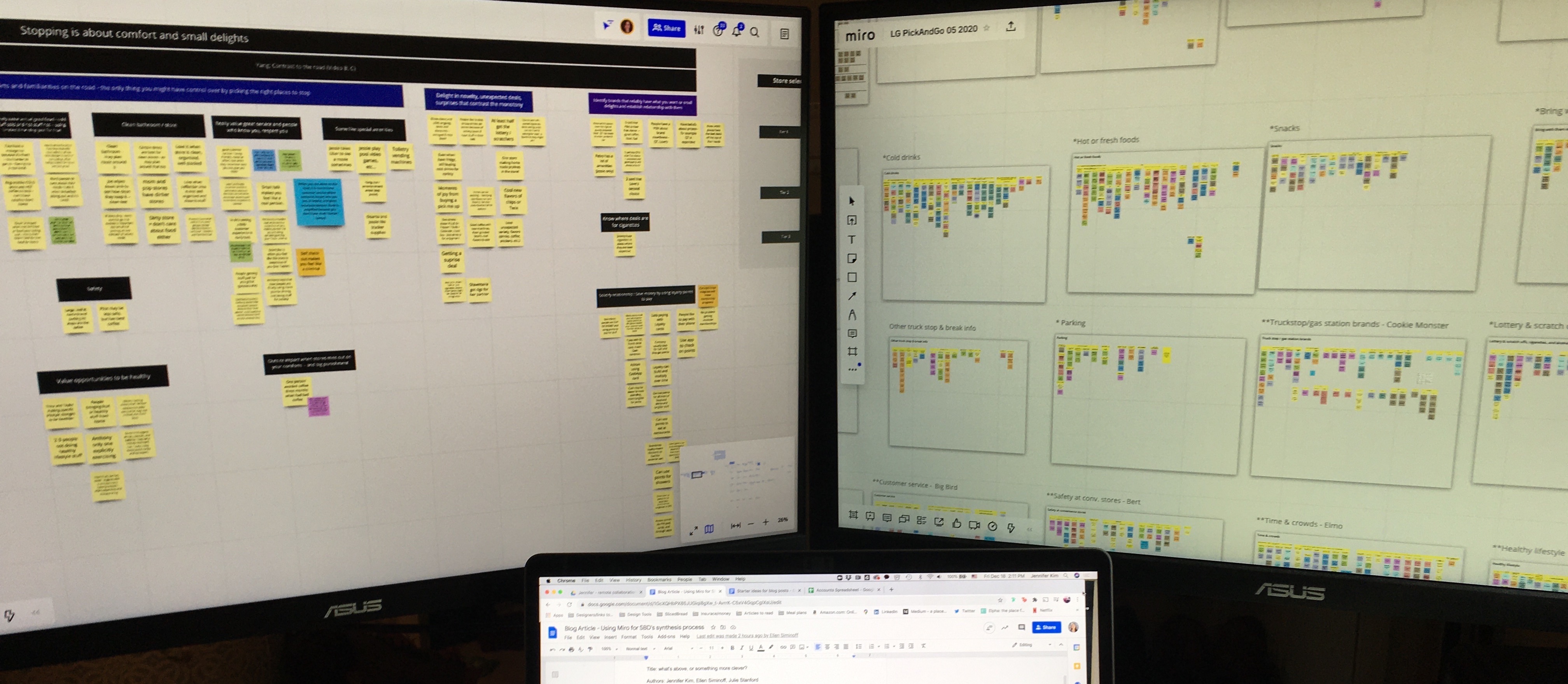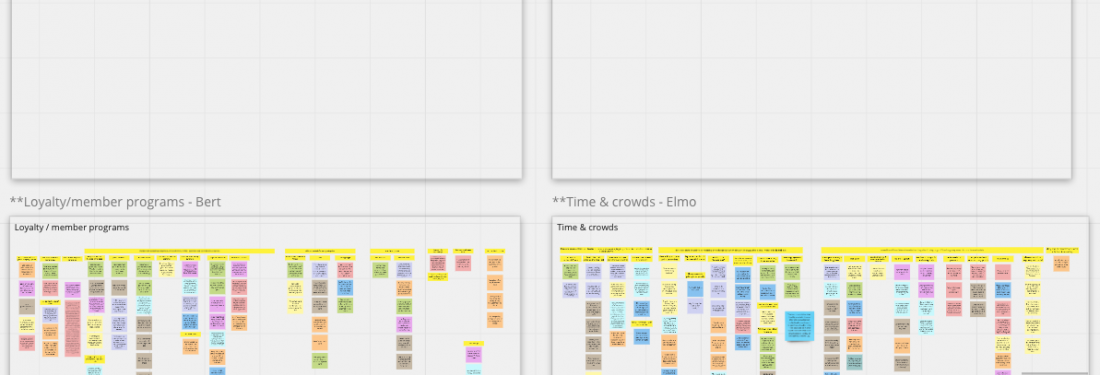There’s been an ongoing skirmish here at Sliced Bread involving a central element of our work: does our synthesis process truly require our rainbow of sticky notes to live in a real room where we could sit together surrounded by them, or could we effectively carry out the creation, rearranging and analysis of literally a room full of sticky notes on a computer screen? Granted, being designers, we have multiple large monitors, and we are good at using technology, but it is a big ask. During our synthesis process we take a whole round of user interviews, convert the findings into color-coded stickies which typically cover up to 140 square feet of physical wall space, and then rearrange them in dynamic ways to analyze our findings and create compelling insights for our clients. The traditionalists argued that our collaboration requires sitting in a real room moving real stickies around. Meanwhile, the agitators argued for the efficiency and environmentally friendly benefits of digital stickies.
Enter COVID-19, which forced our hand to go digital in March 2020. We chose Miro as our platform, which at the time had better functionality than its lead competitor Mural. Now both platforms have similar functionality, but we will use Miro to stand in for all current collaborative virtual workspaces as we discuss the pros and cons of an online sticky analysis process:
Pro: Typing gets the stickies done faster
This one is simple: typing the stickies is a lot faster and legible (hey, yes you with the messy handwriting, what does this one say?) than writing them. Even better, important quotes can be copy/pasted verbatim from interview transcripts instead of having to paraphrase what we can fit in writing on a sticky.
Pro: More flexible organization
Miro lets us use frames to create groupings of stickies that are super well organized without the frustration of having to relocate a whole block of physical sticky notes to a different spot on the wall for the third time. And, if a sticky is relevant in two areas, we can easily duplicate it to include in both. Plus, as an even bigger bonus, it’s easy to create copies of frames to do another organizational pass or try out a crazy idea without ruining the current organization.
Pro: Easier remote collaboration
With our team distributed around the Bay Area and our flexible work from home policy even pre-Covid, it was sometimes a challenge to find enough time to get the project team together in person to work on the sticky process for multiple days. And, to do anything related to the stickies, you have to be in the office. Sending out a Miro link lets people work conveniently from anywhere and also invites easier asynchronous work. For example, in the past we might make stickies at home and then bring them into the office to put them up and only at that point could the team incorporate those thoughts. Now, that creation and incorporation can all happen in a more organic and ongoing manner which is superior. Added bonus: We can invite remote clients to join in and help synthesize as well.

Con: No bouncing ideas off each other in the same room
Here’s one key area that doesn’t work as well online. With in-person stickies, we can speak up at any time and make a comment or ask a question. Those serendipitous conversations can lead to key insights. In contrast, if we want to discuss something while using Miro, we have to post it on Slack or remember to bring it later in a sync up meeting. We’ve sometimes tried to capture some of the qualities of the in person connection with a virtual meeting going as we work on stickies. But, as with so many things, it isn’t really the same. We wonder if the loss of in person cross-talk might lead to fewer connections and aha moments in the synthesis process. And, as we all know, being online is also less fun...something about being in the room with fellow researchers is just more compelling and gives us the zeitgeist of design thinking.
Con: Hard to see the big picture
Another benefit of being in person is literally being in the room where it happens. As effective as Miro and similar software is, we run up against the limitations of software running on a computer. With the large number of stickies and frames we have, it takes a while for things to load. And, scrolling around looking for something specific is sometimes challenging. Because this process is so central to our work, we all now have multiple monitors or one giant one (which is very satisfying but not a solution everyone can choose) so we can have Miro displayed in multiple windows. Having more screen real estate makes it easier to see and keep track of multiple ideas, but it can sometimes be more difficult to see the big picture. In contrast, when we are sitting inside a room full of stickies, we can look around and make physical connections in a way that can’t be done on a screen, at least not yet.
The Bottom Line
Overall, after trial and error using different methods, features, and monitors, our online synthesis process is working well, even for our hard core traditionalists. Although we miss being surrounded by our stickies and the benefits of collaborating in real time, Miro makes creating, organizing and coordinating a lot more efficient. So, will we go back to physical stickies post Covid? At this point, like everything else about the future, all we can say is: we’ll see what happens.


